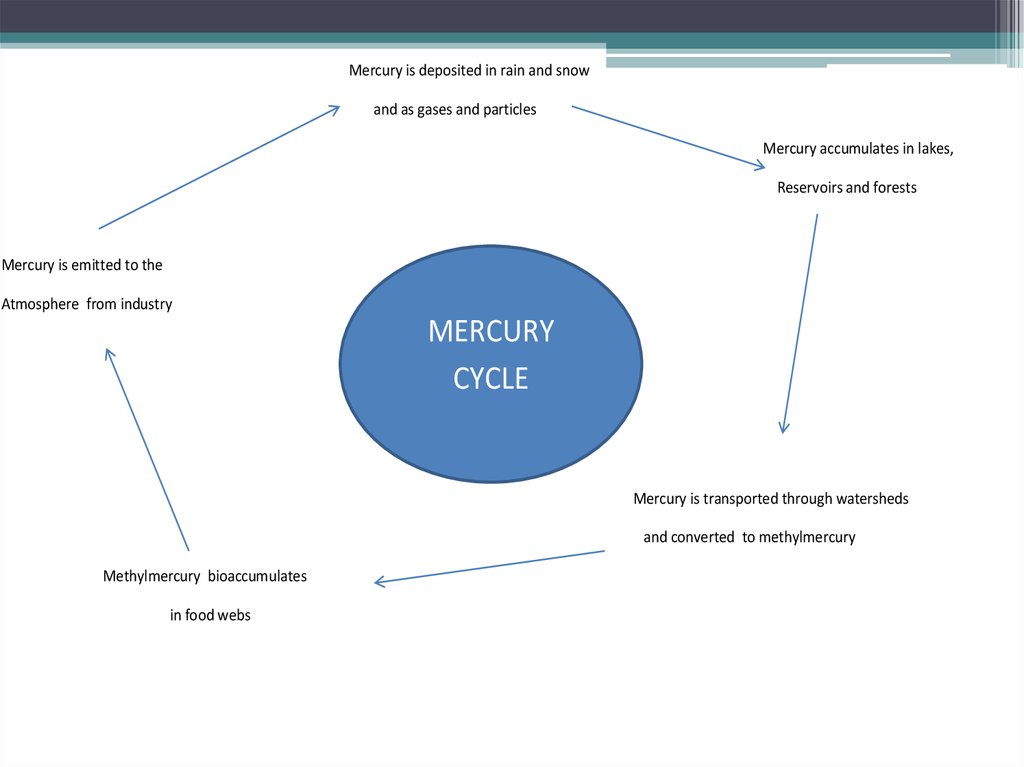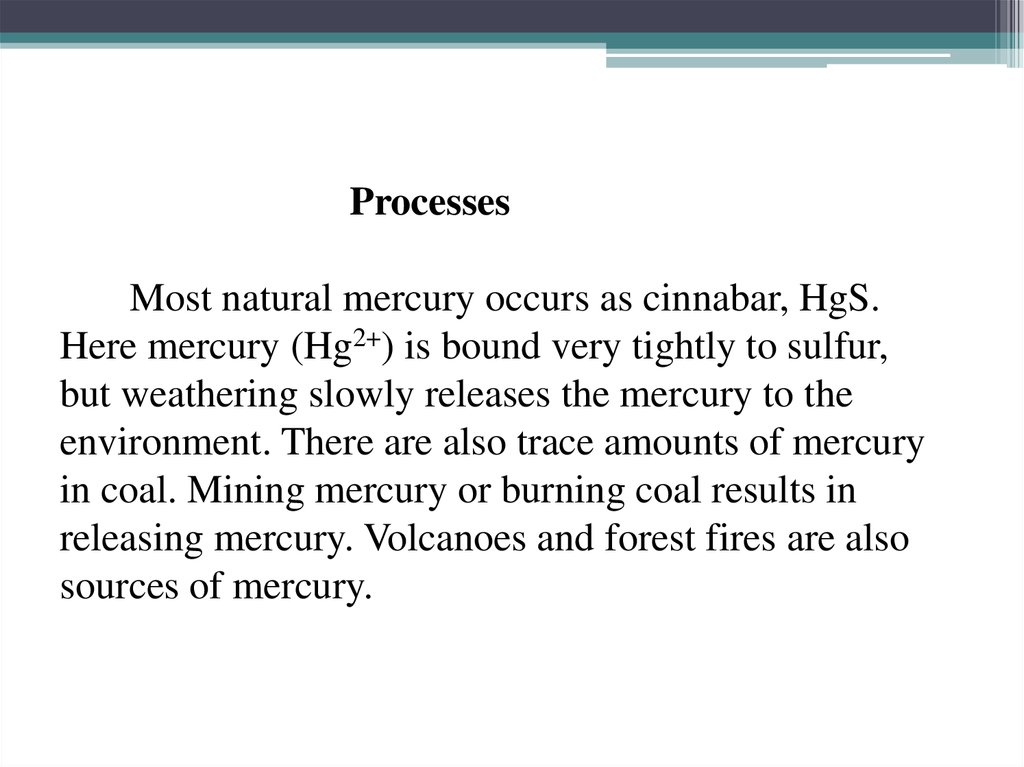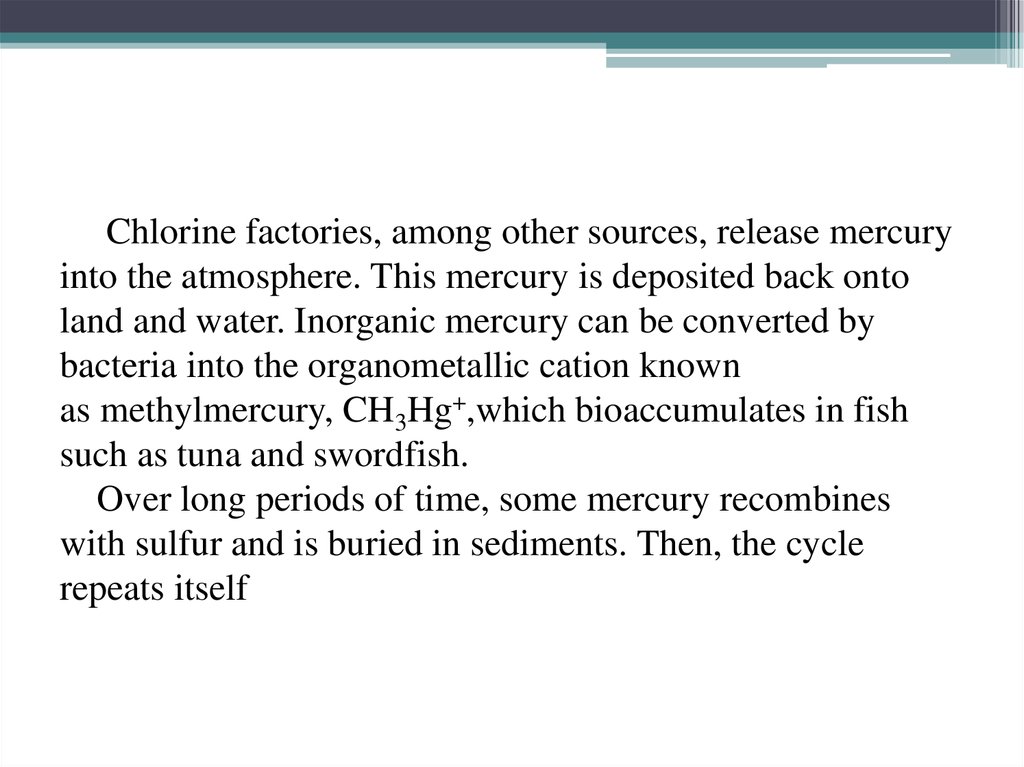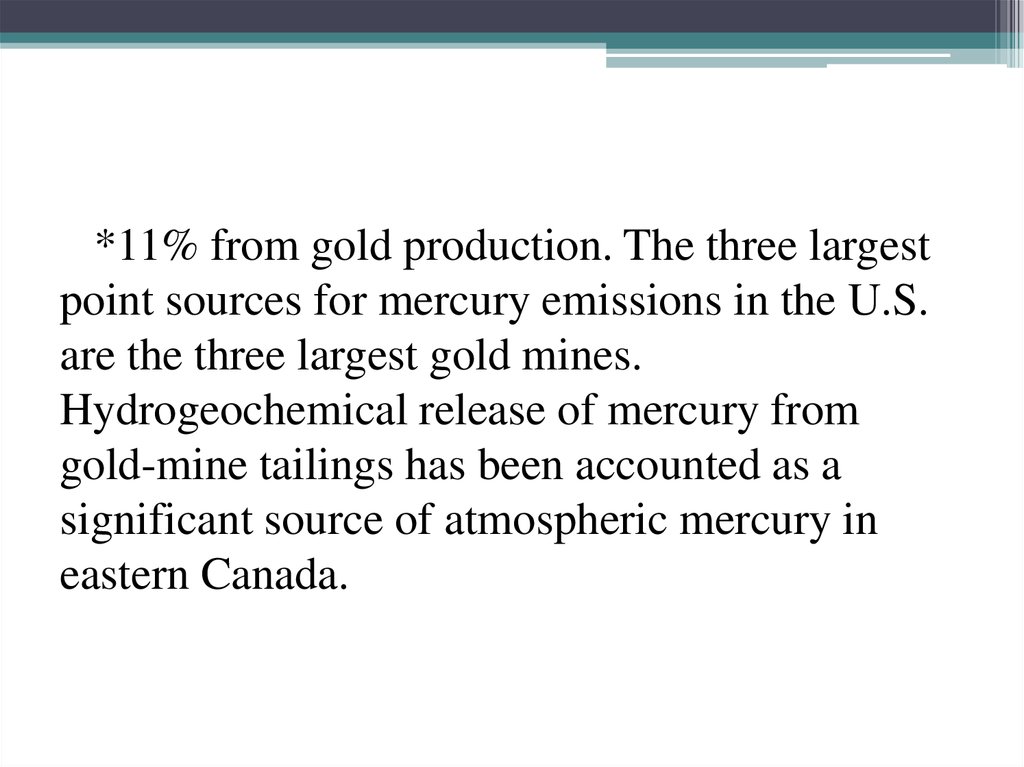Похожие презентации:
Mercury. Mercury cycle
1. Mercury. Mercury cycle.
Worked by: Baigeldin FakhridinovGroup: JEK – 511(F)
2. Plan: 1. Definition about mercury; 2. Etymology of mercury; 3. Properties; 4. Occurrence; 5. Applications; 6. Medicine; 7.
Mercury cycle.3.
4. Mercury is a chemical element with symbol Hg and atomic number 80. It is commonly known as quicksilver and was formerly
Mercury is a chemical element with symbolHg and atomic number 80. It is commonly known
as quicksilver and was formerly named hydrargyrum.
5. A heavy, silvery d-block element, mercury is the only metallic element that is liquid at standard conditions for temperature
A heavy, silvery d-block element, mercury is the onlymetallic element that is liquid at standard conditions for
temperature and pressure; the only other element that is
liquid under these conditions is bromine, though metals such
as calesium, gallium, and rubidium melt just above room
temperature.
6. Mercury occurs in deposits throughout the world mostly as cinnabar (mercuric sulfide). The red pigment vermilion is obtained by
Mercury occurs in deposits throughout the world mostlyas cinnabar (mercuric sulfide). The red pigment vermilion is
obtained by grinding natural cinnabar or synthetic mercuric
sulfide.
Mercury is used
in thermometers, barometers, manometers,
sphygmomanometers, float valves, mercury switches, mercury
relays, fluorescent lamps and other devices, though concerns
about the element's toxicity have led to mercury thermometers
and sphygmomanometers being largely phased out in clinical
environments in favor of alternatives such as alcoholor galinstan-filled glass thermometers and thermistoror infrared-based electronic instruments.
7.
8. Etymology Hg is the modern chemical symbol for mercury. It comes from hydrargyrum, a Latinized form of the Greek word
EtymologyHg is the modern chemical symbol for mercury. It comes
from hydrargyrum, a Latinized form of the Greek word
(hydrargyros), which is a compound word meaning "water-silver"
(from - hydr-, the root , "water," and argyros "silver") – since it is
liquid like water and shiny like silver.
9. Properties Physical properties Mercury is a heavy, silvery-white liquid metal. Compared to other metals, it is a poor conductor
of heat,but a fair conductor of electricity
10. It has a freezing point of −38.83 °C and a boiling point of 356.73 °C, both the lowest of any metal. Upon freezing, the volume
It has a freezing point of −38.83 °C and a boiling point of356.73 °C, both the lowest of any metal. Upon freezing, the
volume of mercury decreases by 3.59% and its density
changes from 13.69 g/cm3 when liquid to 14.184
g/cm3 when solid. The coefficient of volume expansion is
181.59 × 10−6 at 0 °C, 181.71 × 10−6 at 20 °C and 182.50 ×
10−6 at 100 °C (per °C). Solid mercury is malleable and
ductile and can be cut with a knife.
11.
12. Chemical properties Mercury does not react with most acids, such as dilute sulfuric acid, although oxidizing acids such as
Chemical propertiesMercury does not react with most acids, such as
dilute sulfuric acid, although oxidizing acids such as
concentrated sulfuric acid and nitric acid or aqua
regia dissolve it to give sulfate, nitrate, and chloride.
Like silver, mercury reacts with atmospheric hydrogen
sulfide. Mercury reacts with solid sulfur flakes, which
are used in mercury spill kits to absorb mercury (spill
kits also use activated carbon and powdered zinc).
13. Occurrence Mercury is an extremely rare element in Earth's crust, having an average crustal abundance by mass of only 0.08
OccurrenceMercury is an extremely rare element in Earth's crust,
having an average crustal abundance by mass of only
0.08 parts per million (ppm).
Because it does not blend geochemically with those
elements that constitute the majority of the crustal mass,
mercury ores can be extraordinarily concentrated
considering the element's abundance in ordinary rock.
14. Applications Mercury is used primarily for the manufacture of industrial chemicals or for electrical and electronic
applications. It is used in some thermometers, especiallyones which are used to measure high temperatures.
A still increasing amount is used as gaseous mercury
in fluorescent lamps, while most of the other
applications are slowly phased out due to health and
safety regulations and is in some applications replaced
with less toxic but considerably more
expensive Galinstan alloy.
15. The bulb of a mercury-in-glass thermometer
The bulb of a mercury-in-glass thermometer16. Medicine Mercury and its compounds have been used in medicine, although they are much less common today than they once were,
now that the toxic effects ofmercury and its compounds are more widely
understood. The first edition of the Merck's Manual
featured many mercuric compounds.
Mercury is an ingredient in dental
amalgams. Thiomersal (called Thimerosal in the United
States) is an organic compound used as
a preservative in vaccines, though this use is in decline.
17. Amalgam filling
18. Mercury cycle The mercury cycle is a biogeochemical cycle involving mercury. Mercury is notable for being the only metal which
Mercury cycleThe mercury cycle is a biogeochemical
cycle involving mercury. Mercury is notable for being
the only metal which is liquid at room temperature. It is
a volatile metal and evaporates, though it takes quite a
while to do so.
19.
Mercury is deposited in rain and snowand as gases and particles
Mercury accumulates in lakes,
Reservoirs and forests
Mercury is emitted to the
Atmosphere from industry
MERCURY
CYCLE
Mercury is transported through watersheds
and converted to methylmercury
Methylmercury bioaccumulates
in food webs
20.
21. Processes Most natural mercury occurs as cinnabar, HgS. Here mercury (Hg2+) is bound very tightly to sulfur,
ProcessesMost natural mercury occurs as cinnabar, HgS.
Here mercury (Hg2+) is bound very tightly to sulfur,
but weathering slowly releases the mercury to the
environment. There are also trace amounts of mercury
in coal. Mining mercury or burning coal results in
releasing mercury. Volcanoes and forest fires are also
sources of mercury.
22. Chlorine factories, among other sources, release mercury into the atmosphere. This mercury is deposited back onto land and
Chlorine factories, among other sources, release mercuryinto the atmosphere. This mercury is deposited back onto
land and water. Inorganic mercury can be converted by
bacteria into the organometallic cation known
as methylmercury, CH3Hg+,which bioaccumulates in fish
such as tuna and swordfish.
Over long periods of time, some mercury recombines
with sulfur and is buried in sediments. Then, the cycle
repeats itself
23. Anthropogenic emissions of mercury The human-generated half can be divided into the following estimated percentages: *65% from
stationary combustion, of which coal-firedpower plants are the largest aggregate source (40% of
U.S. mercury emissions in 1999). This includes power
plants fueled with gas where the mercury has not been
removed. Emissions from coal combustion are between
one and two orders of magnitude higher than emissions
from oil combustion, depending on the country.
24. *11% from gold production. The three largest point sources for mercury emissions in the U.S. are the three largest gold mines.
Hydrogeochemical release of mercury fromgold-mine tailings has been accounted as a
significant source of atmospheric mercury in
eastern Canada.

























 Химия
Химия





